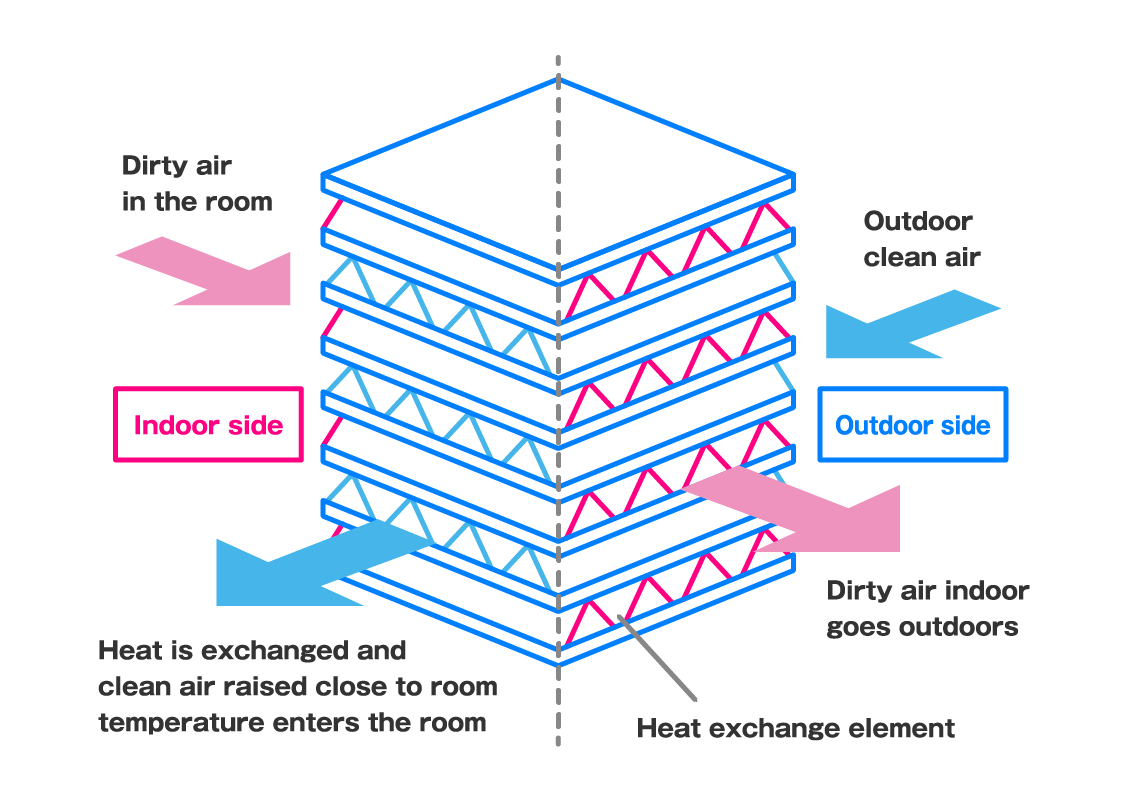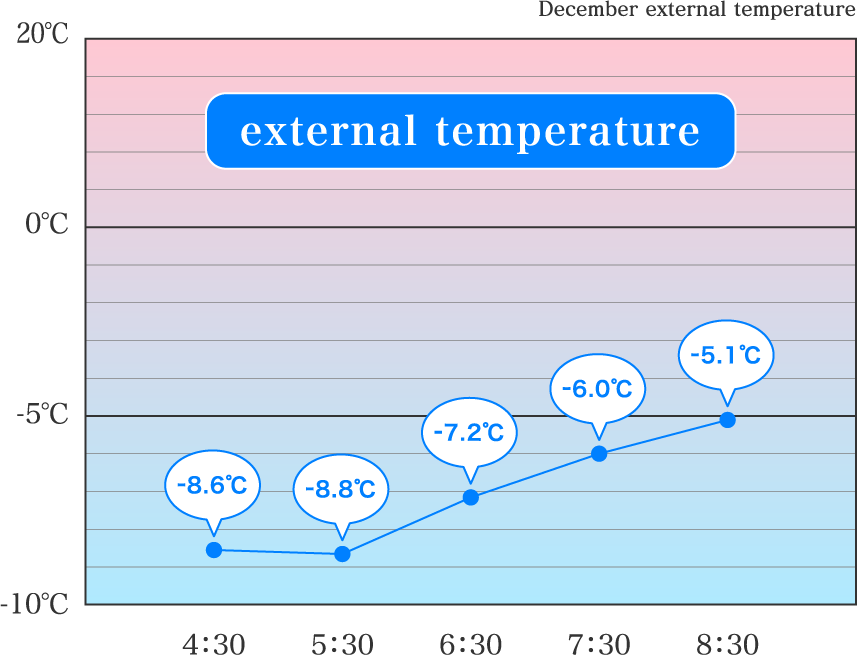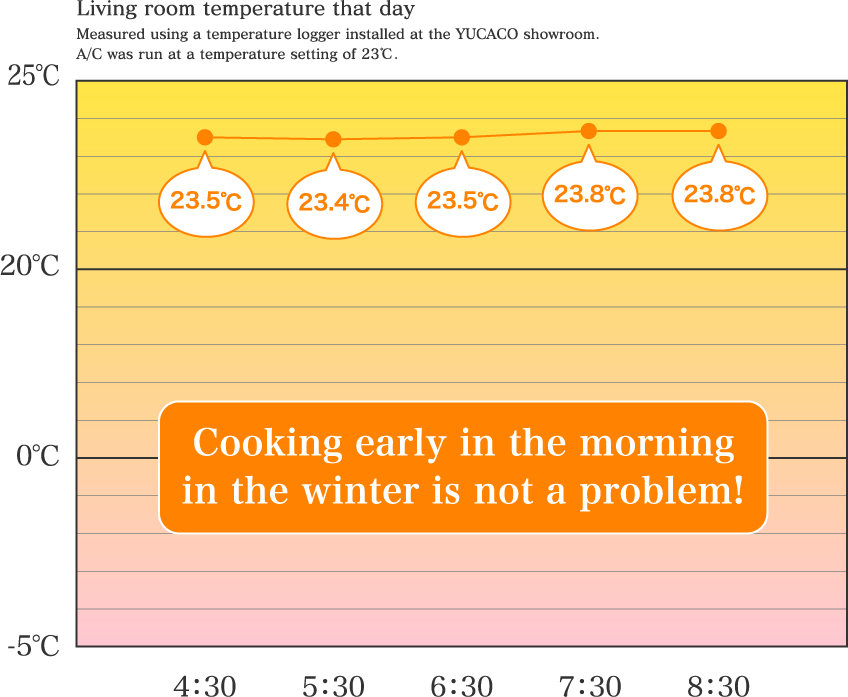
Maximizing the potential of the “highly airtight and highly insulated homes” boasted by RID HOUSE, this is a central air conditioning (A/C) system that uses a single residential home A/C unit to make homes cool in the summer and warm in the winter, no matter where you are in the house.
The (warmed/cooled) air released from the A/C installed in the A/C chamber is pushed by circulators (DC fans) and travels through ducts to provide fresh air from vents installed in each room. This system means the entire house is maintained at a consistent and pleasant temperature, not only in each room but also in hallways and bathrooms. This system uses a Class I heat exchange ventilation system. This ensures good energy efficiency when heating or cooling air drawn from the outside and contributes to reducing heating and cooling expenses.


Concept of air warmed (cooled) in the AC chamber flowing to each room

There is no need to install an A/C unit in each room, creating a neat space

Eliminating temperature differences in hallways and changing rooms means no heat shock

Cooking early in the morning in winter is not a problem

Laundry dries overnight, even in the middle of winter



A room installed on the 2nd floor or 1st floor where air that returns from each room is mixed with fresh air from the outside.
Before the mixed air enters the A/C chamber, it is purified by a filter. External air passes through a heat exchange, so temperature and humidity are maintained when it flows into the A/C chamber. Air intake is then supplied to all rooms via DC fans.

The A/C chamber is equipped with a residential air conditioner, compact, high-performance DC fans, and switches for controlling the airflow to each room. (The standard size A/C unit for a building with a floor surface area of 60 tsubo (200sq/m) is a unit designed for 14 tatami mats (23sq/m).)
Air purified with a filter passes through the A/C unit to create clean, comforting air.

Air conditioned to the set temperature travels to each room from the A/C via ducts. Air floors from a filter to the slits in the floor on the first floor, and from the ceiling on the second floor.

The YUCACO system uses a Class I heat exchange ventilation system. A Class I heat exchange ventilation system is a system that passes fresh air drawn from the outside and indoor air being exhausted outside through a heat exchange, to bring the fresh air to a temperature near room temperature.

Achieve a lifestyle of comfort and peace of mind in room temperatures between 23℃ and 25℃ all year long, even on the hottest mid-summer days when temperatures exceed 30℃ or the harshest winter days with temperatures below freezing.
Air is sent to rooms at a speed of 1m/s, meaning there is none of the discomfort from comes from direct heating or cooling.

Equipped with a circulation air purification system, it removes house dust (mold, viruses, pollen, PM2.5, yellow sand) to fill your home with clean air no matter where you are.

RID HOUSE offers highly insulated, highly air-tight, and high- performance living. With the YUCACO System, you can significantly reduce heating and cooling costs though air conditioning the entire home with a single A/C unit.
In a typical house, 4 to 5 deteriorated air conditioners in each room are replaced at a time, meaning you can save you a lot of money from the cost of replacing the air conditioners alone. Also, this system uses only one air conditioner, so the hassle of filter cleaning is reduced.

UA value / outer skin average heat transfer coefficient
The UA value represents the average amount of heat that escapes from the inside of the house to the outside, and is an index that indicates the average heat cost flow rate of the entire building envelope.
The formula is the total heat loss per unit temperature difference divided by the exterior surface area. The smaller the UA value, the more difficult it is for heat to escape, indicating higher insulation performance.
RID HOUSE has so far recorded a UA value of 0.19 for G3 grade, the highest standard, and has achieved a home with insulation grade 7, the highest grade.
About G3
G3 standard homes have the ability to maintain a sensible indoor temperature of 16°C or higher in winter in Hokkaido, and 15°C or higher in other regions, while taking energy savings into account. It is the highest standard for Japanese housing, combining the quality of the living environment and energy-saving performance with an optimal balance. Even unheated hallways and changing rooms are maintained at a temperature of 13℃ or above, which reduces temperature differences within the residence and improves health and comfort.
About C value
Equivalent gap area (C value) is the value obtained by measuring the gap in your house and dividing the area of the gap by the floor area. To measure the gap, close all openings that have been made intentionally, such as ventilation openings, and use a blower to force indoor air out. The C value is measured based on the air pressure difference and air volume that occur at this time.

RID HOUSE home equipped with the YUCACO system. You can view graphs to see actual temperatures for each room.
Easy to see that it is comfortable in every part of the home.
Currently unavailable

Is it okay in humid seasons?
Since the system circulates with a large amount of air, you won't feel uncomfortable even when it's humid outside.
Won't odors spread throughout the house?
You may notice some odors, but they will be diluted and diffused throughout the house, so odors will become less noticeable after a short period of time.
Is the whole house kept warm with just one air conditioner?
The house is highly airtight, highly insulated, and has improved performance, making it difficult for heat to escape. Therefore, you can live comfortably anywhere in your home with the performance of a single air conditioner.
Will mold grow inside the ducts?
Mold will not grow because ducts are not connected to the outside air and there is little temperature difference between the inside and outside of the duct.






















![[Energy saving standard] UA value 0.36](/cms/cms-content/themes/rid/assets/images/yucaco/en/economizing_text_01.svg)

![[YUCACO system] UA value 0.25](/cms/cms-content/themes/rid/assets/images/yucaco/en/economizing_text_02.svg)


![[YUCACO + Share Denki] UA value 0.25](/cms/cms-content/themes/rid/assets/images/yucaco/en/economizing_text_03.svg)










